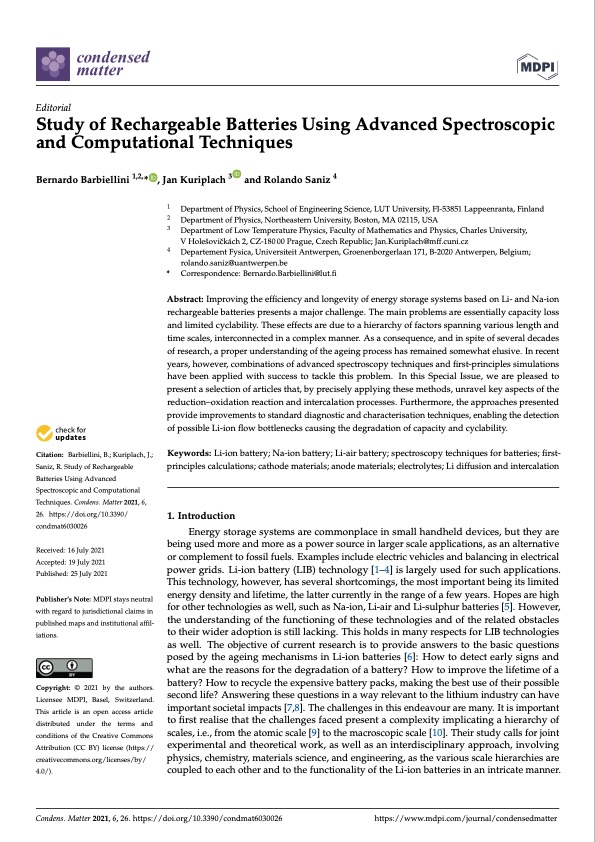
PDF Publication Title:
Text from PDF Page: 001
Editorial Study of Rechargeable Batteries Using Advanced Spectroscopic and Computational Techniques Bernardo Barbiellini 1,2,* , Jan Kuriplach 3 and Rolando Saniz 4 Citation: Barbiellini, B.; Kuriplach, J.; Saniz, R. Study of Rechargeable Batteries Using Advanced Spectroscopic and Computational Techniques. Condens. Matter 2021, 6, 26. https://doi.org/10.3390/ condmat6030026 Received: 16 July 2021 Accepted: 19 July 2021 Published: 25 July 2021 Publisher’s Note: MDPI stays neutral with regard to jurisdictional claims in published maps and institutional affil- iations. Copyright: © 2021 by the authors. Licensee MDPI, Basel, Switzerland. This article is an open access article distributed under the terms and conditions of the Creative Commons Attribution (CC BY) license (https:// creativecommons.org/licenses/by/ 4.0/). 1 2 3 Abstract: Improving the efficiency and longevity of energy storage systems based on Li- and Na-ion rechargeable batteries presents a major challenge. The main problems are essentially capacity loss and limited cyclability. These effects are due to a hierarchy of factors spanning various length and time scales, interconnected in a complex manner. As a consequence, and in spite of several decades of research, a proper understanding of the ageing process has remained somewhat elusive. In recent years, however, combinations of advanced spectroscopy techniques and first-principles simulations have been applied with success to tackle this problem. In this Special Issue, we are pleased to present a selection of articles that, by precisely applying these methods, unravel key aspects of the reduction–oxidation reaction and intercalation processes. Furthermore, the approaches presented provide improvements to standard diagnostic and characterisation techniques, enabling the detection of possible Li-ion flow bottlenecks causing the degradation of capacity and cyclability. Keywords: Li-ion battery; Na-ion battery; Li-air battery; spectroscopy techniques for batteries; first- principles calculations; cathode materials; anode materials; electrolytes; Li diffusion and intercalation 1. Introduction Energy storage systems are commonplace in small handheld devices, but they are being used more and more as a power source in larger scale applications, as an alternative or complement to fossil fuels. Examples include electric vehicles and balancing in electrical power grids. Li-ion battery (LIB) technology [1–4] is largely used for such applications. This technology, however, has several shortcomings, the most important being its limited energy density and lifetime, the latter currently in the range of a few years. Hopes are high for other technologies as well, such as Na-ion, Li-air and Li-sulphur batteries [5]. However, the understanding of the functioning of these technologies and of the related obstacles to their wider adoption is still lacking. This holds in many respects for LIB technologies as well. The objective of current research is to provide answers to the basic questions posed by the ageing mechanisms in Li-ion batteries [6]: How to detect early signs and what are the reasons for the degradation of a battery? How to improve the lifetime of a battery? How to recycle the expensive battery packs, making the best use of their possible second life? Answering these questions in a way relevant to the lithium industry can have important societal impacts [7,8]. The challenges in this endeavour are many. It is important to first realise that the challenges faced present a complexity implicating a hierarchy of scales, i.e., from the atomic scale [9] to the macroscopic scale [10]. Their study calls for joint experimental and theoretical work, as well as an interdisciplinary approach, involving physics, chemistry, materials science, and engineering, as the various scale hierarchies are coupled to each other and to the functionality of the Li-ion batteries in an intricate manner. Department of Physics, School of Engineering Science, LUT University, FI-53851 Lappeenranta, Finland Department of Physics, Northeastern University, Boston, MA 02115, USA Department of Low Temperature Physics, Faculty of Mathematics and Physics, Charles University, V Holešovicˇkách 2, CZ-180 00 Prague, Czech Republic; Jan.Kuriplach@mff.cuni.cz 4 rolando.saniz@uantwerpen.be Departement Fysica, Universiteit Antwerpen, Groenenborgerlaan 171, B-2020 Antwerpen, Belgium; * Correspondence: Bernardo.Barbiellini@lut.fi Condens. Matter 2021, 6, 26. https://doi.org/10.3390/condmat6030026 https://www.mdpi.com/journal/condensedmatterPDF Image | Study of Rechargeable Batteries Using Advanced Spectroscopic and Computational Techniques

PDF Search Title:
Study of Rechargeable Batteries Using Advanced Spectroscopic and Computational TechniquesOriginal File Name Searched:
condensedmatter-06-00026-v2.pdfDIY PDF Search: Google It | Yahoo | Bing
Sulfur Deposition on Carbon Nanofibers using Supercritical CO2 Sulfur Deposition on Carbon Nanofibers using Supercritical CO2. Gamma sulfur also known as mother of pearl sulfur and nacreous sulfur... More Info
CO2 Organic Rankine Cycle Experimenter Platform The supercritical CO2 phase change system is both a heat pump and organic rankine cycle which can be used for those purposes and as a supercritical extractor for advanced subcritical and supercritical extraction technology. Uses include producing nanoparticles, precious metal CO2 extraction, lithium battery recycling, and other applications... More Info
| CONTACT TEL: 608-238-6001 Email: greg@infinityturbine.com | RSS | AMP |